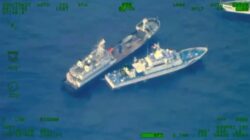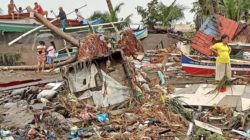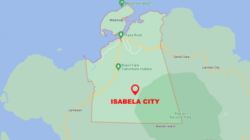MANILA, Philippines – Typhoon Noru blasted across the northern Philippines on Monday, killing five rescuers, creating floods and power outages, and forcing officials to cancel courses and government operations in the capital and outlying provinces.
The most violent typhoon to hit the country this year blasted into the coast in Burdeos, Quezon province, before dusk on Sunday, then weakened as it barreled overnight across the main Luzon area, where officials claimed thousands of people were forced to evacuate to emergency shelters.
Gov. Daniel Fernando of Bulacan province, north of Manila, said five rescuers were using a boat to help citizens stranded in floodwaters when they were hit by a collapsing wall and drowned.
“They were living heroes who were helping rescue our countrymen’s lives in the midst of this tragedy,” Fernando told the DZMM radio network. “This is just heartbreaking.”
A man was hurt after falling over the top of his house on Polillo island in northeastern Quezon province, according to officials.
According to officials, more than 17,000 people were relocated to emergency shelters from high-risk villages prone to tidal surges, flooding, and landslides in Quezon alone.
More than 3,000 people were evacuated to safety in Metro Manila, which had been battered by strong winds and rain overnight. Despite the beautiful sky in the morning, classes and government work were canceled throughout the capital and outlying regions on Monday.
The entire northern provinces of Aurora and Nueva Ecija, which were hit by the typhoon, remained without power Monday, and repair crews were working to restore power, Energy Secretary Raphael Lotilla said in a televised meeting called by President Ferdinand Marcos Jr. to assess damages and coordinate disaster response.
Marcos Jr. thanked officials for removing thousands of people to safety before the typhoon hit, resulting in fewer casualties despite the Noru’s potentially destructive fury. He directed that supplies be airlifted and clean-up equipment be delivered to the hardest-hit communities.
“The moment at which we may stand down is when the bulk of evacuees have already returned home,” Marcos said during a news conference with disaster management authorities on Monday, referring to the storm’s 74,000 residents who were pushed into evacuation camps.
Officials stated that cleanup work in Luzon, which accounts for more than two-thirds of the country’s economy and about half of its 110 million people, began as floodwaters receded in the capital region.
Noru experienced “explosive intensification” over the open Pacific Ocean before making landfall in the Philippines, according to Vicente Malano, head of the country’s weather agency PAGASA, who spoke to The Associated Press on Sunday.
Noru grew from a tropical storm with sustained winds of 85 kilometers per hour (53 mph) on Saturday to a super typhoon with sustained winds of 195 kilometers (121 miles per hour) and gusts of up to 240 kph (149 mph) at its peak late Sunday.
According to the weather service, Noru had sustained winds of 140 kph (87 mph) with gusts of 170 kph (105 mph) and was moving westward in the South China Sea at 30 kph (19 mph).
Every year, the Philippines is hit by about 20 storms and typhoons. The archipelago is also located in the “Pacific Ring of Fire,” an area along the Pacific Ocean’s rim where frequent volcano eruptions and earthquakes occur, making Southeast Asia one of the most disaster-prone countries in the world.
In 2013, Typhoon Haiyan, one of the world’s strongest known tropical cyclones, killed or went missing over 7,300 people, devastated entire communities, swept ships inland, and displaced over 5 million people in the central Philippines – much to the south of Noru’s route.
Source: AP and Reuters










